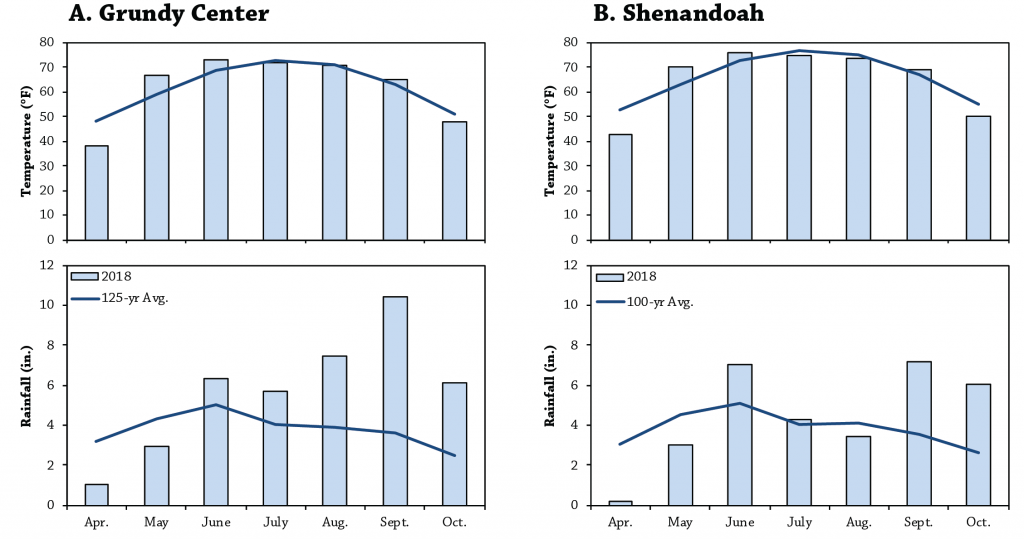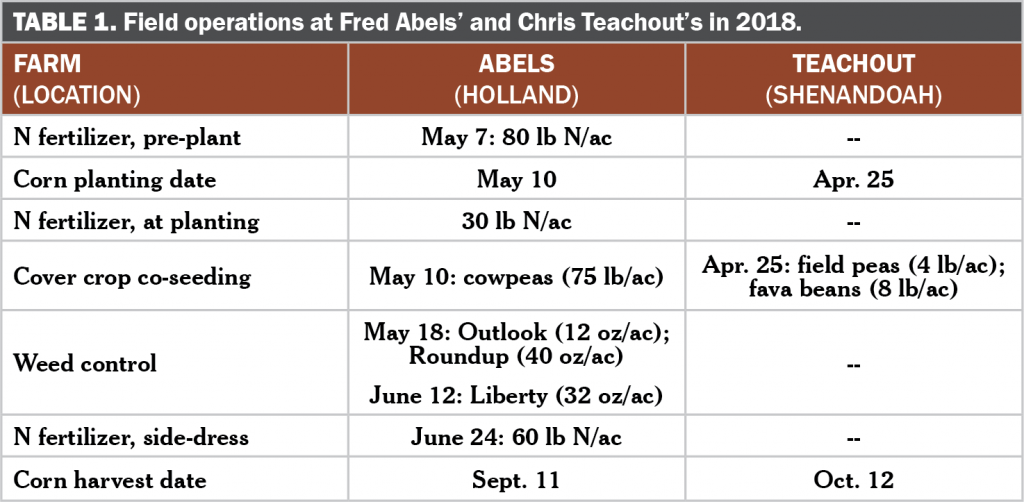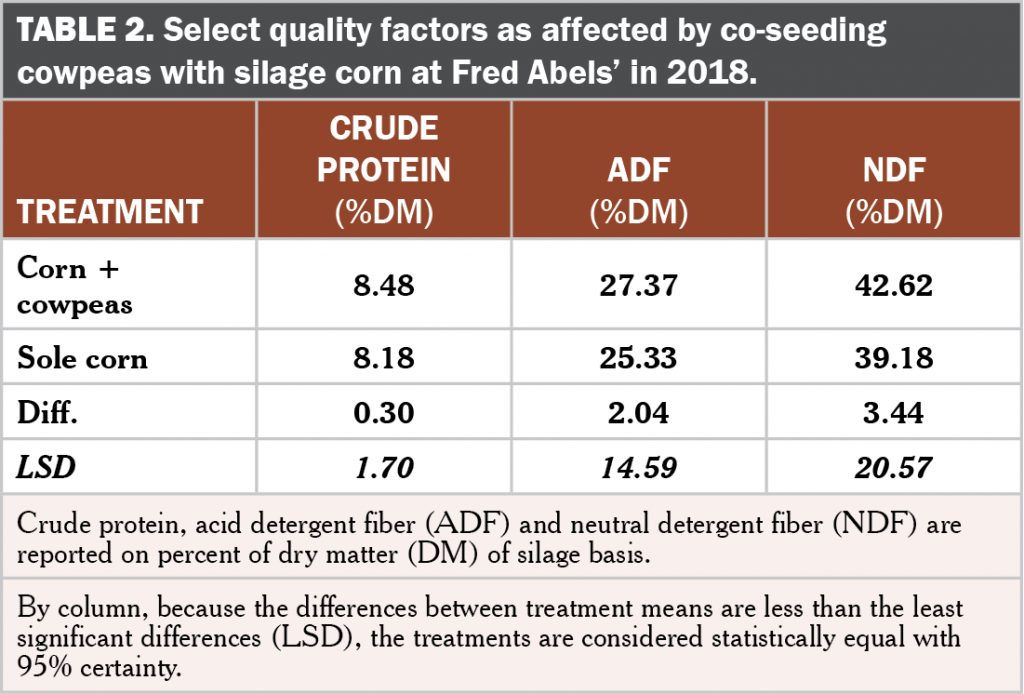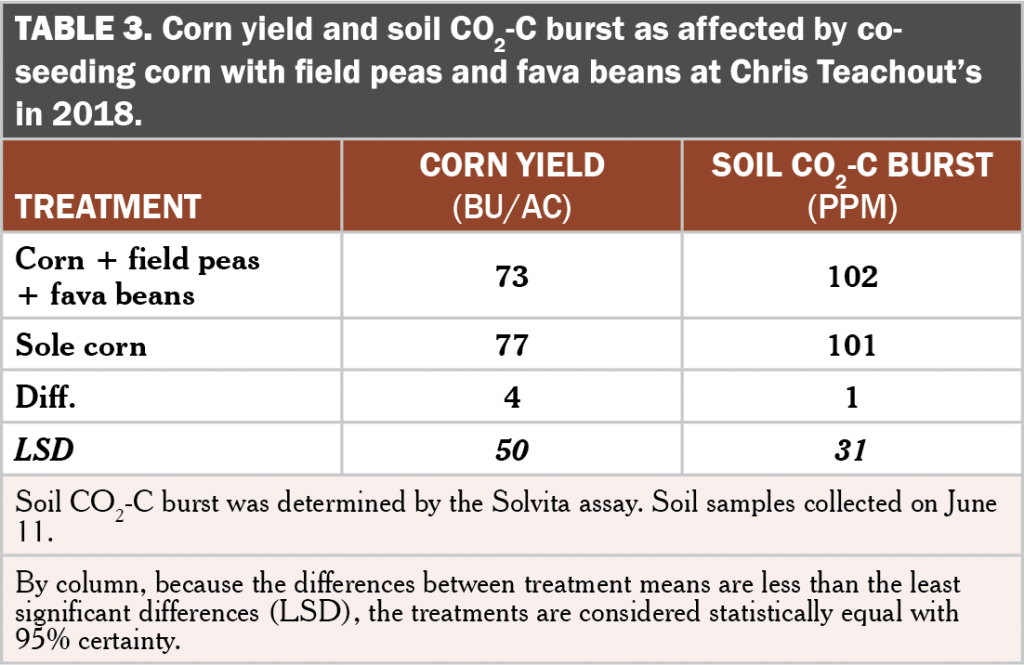This project was supported by the Walton Family Foundation
In a Nutshell:
- Cover crops are typically seeded near or after cash crop harvest in late summer or early fall in the Upper Midwest. Seeding cover crops at the time of cash crop planting (co-seeding), however, could present opportunities for more diverse cover crops and attendant benefits to crop production.
Key Findings:
- Fred Abels grew silage corn with co-seeded cowpeas and found no improvements in forage quality in terms of crude protein, acid detergent fiber or neutral detergent fiber.
- Chris Teachout assessed corn grain yields when the corn was co-seeded with field peas and fava beans. Grain yields were no different than those resulting from sole crop corn grown with no co-seeding.
Background
Seeding cover crops early in the growing season (spring, summer) has been gaining farmer attention. This strategy presents opportunities for legume and warm-season cover crop species that cannot be established later in the growing season after cash crop harvest (when cover crops like cereal rye are typically seeded in the Upper Midwest). Research in Nebraska has investigated cover crop mixes seeded early in the spring (late March) prior to terminating and planting corn in late May.[1] Other studies in Iowa[2] and Wisconsin[3,4] have explored living mulch cover crops that are established prior to corn and are chemically or mechanically suppressed during the corn growing season. Recent research by Practical Farmers of Iowa cooperators has explored interseeding cover crop mixes to seed corn[5] and field corn[6,7] in June. Across all of these past studies, success rates of cover crop establishment and effects on corn yield resulting from the strategies were mixed. Another opportunity for establishing cover crops could be seeding cover crops at the same time as planting corn (co-seeding). Farmers have begun to wonder if this strategy can successfully establish cover crops and bring benefits to soil quality and crop productivity. Success in this case could be defined as less inputs needed for crop production without compromising yields.
Objective: Determine the effect on corn silage and grain yield of co-seeding a legume cover crop with the corn at the time of planting.
Methods
These experimental trials were conducted by Fred Abels near Holland in Grundy County and Chris Teachout near Shenandoah in Fremont County. Abels compared silage corn co-seeded with cowpeas and sole silage corn. He was interested in learning if co-seeding with cowpeas could improve silage yields and quality. The two treatments were replicated three times in randomized strips. Teachout evaluated corn grain yields resulting from co-seeding corn with field peas and fava beans compared to sole crop corn. He chose to apply no N fertilizer in an attempt to gauge any soil fertility benefits from the co-seeded legume cover crops. Treatments were replicated four times in randomized strips. Crop management details for both farms are provided in Table 1.
Teachout collected soil samples to a depth of 6-in. on June 11. Samples were sent to AgSource Laboratories (Ellsworth, IA) to determine the burst of CO2-C following rewetting of dried soil using the Solvita assay. Corn grain was harvested individually from each strip at Teachout’s and corrected to 15.5% moisture. Abels collected forage samples from each individual strip the day of silage harvest and sent them to Dairyland Laboratories, Inc. (Arcadia, WI) for analysis.
Data were analyzed using JMP Pro 13 (SAS Institute Inc., Cary, NC) statistical software. Means separations are reported using the least significant difference (LSD) generated by a t-test. Statistical significance was determined at the 95% confidence level.
Results and discussion
Abels – corn silage
Abels did not harvest each strip of silage corn individually. Across the experimental area, he estimated no differences among the strips; about 10 tons of silage per each strip regardless of the co-seeded cowpeas. Abels did collect forage samples from each strip during silage harvest for crude protein, acid detergent fiber and neutral detergent fiber analysis. Among the three silage quality factors assessed, there were no differences between the corn co-seeded with cowpeas and sole crop corn (Table 2). Researchers in Wisconsin have found improved forage yields and crude protein of silage when the corn was interseeded with living mulch cover crops like kura clover or red clover.[8]
Neither corn grain yield nor soil CO2-C burst were affected by co-seeding corn with field peas and fava beans at Teachout’s (Table 3). Teachout’s corn yields were far below the five-year Fremont County average of 183 bu/ac.[9] He chose to apply no N fertilizer to the corn in this study in an effort to determine any soil fertility benefit from the co-seeded legume cover crops. While legume cover crops can improve corn yields,[10] these benefits are generally seen in the years after the legume rather than during the legume establishment year.[11]
Conclusions and Next Steps
These experiments by Fred Abels and Chris Teachout assessed the effects of co-seeding legume cover crops to corn at the time of planting on corn silage and grain production. Neither farmer measured any effects of yield, quality or soil health from the co-seeded legumes. In these instances, the legume cover crops can be considered extra expenses and further research on this technique is probably warranted before broad-scale adoption.
Appendix – Weather Conditions

Figure A1. Mean monthly temperature and rainfall for Apr. 1 through Oct. 31 and the long-term averages at the nearest weather stations to each farm.[12] A) Grundy Center (Abels, about 4 miles away); B) Shenandoah (Teachout, about 2 miles away).
References
- Wortman, S.E., C.A. Francis, M.L. Bernards, R.A. Drijber and J.L. Lindquist. 2012. Optimizing cover crop benefits with diverse mixtures and an alternative termination method. Agronomy Journal. 104:1425–1435. https://digitalcommons.unl.edu/cgi/viewcontent.cgi?article=1615&context=agronomyfacpub (accessed May 2019).
- Sawyer, J.E., P. Pedersen, D.W. Barker, D.A. Ruiz Diaz and K. Albrecht. 2010. Intercropping corn and kura clover: Response to nitrogen fertilization. Agronomy Journal. 102:568–574. https://dl.sciencesocieties.org/publications/aj/abstracts/102/2/568 (accessed May 2019).
- Affeldt, R.P., K.A. Albrecht, C.M. Boerboom and E.J. Bures. 2004. Integrating Herbicide-Resistant Corn Technology in a Kura Clover Living Mulch System. Agronomy Journal. 96:247–251. https://www.researchgate.net/profile/Kenneth_Albrecht/publication/297554352_Integrating_herbicide-resistant_corn_technology_in_a_kura_clover_living_mulch_system/links/5852e6fd08ae95fd8e1d757a.pdf (accessed May 2019).
- Zemenchik, R.A., K.A. Albrecht, C.M. Boerboom and J.G. Lauer. 2000. Corn production with kura clover as a living mulch. Agronomy Journal. 92:698–705. http://corn.agronomy.wisc.edu/pubs/JL_JournalArticles/92-698.pdf (accessed May 2019).
- Gailans, S. and J. Boyer. 2016. Interseeding Cover Crops in Seed Corn at the V4-V6 Stage. Practical Farmers of Iowa Cooperators’ Program. https://practicalfarmers.org/research/interseeding-cover-crops-in-seed-corn-at-the-v4-v6-stage/ (accessed May 2019).
- Gailans, S., J. Boyer and J. Gustafson. 2017. Corn Leaf Architecture for Interseeded Cover Crops. Practical Farmers of Iowa Cooperators’ Program. https://practicalfarmers.org/research/corn-leaf-architecture-for-interseeded-cover-crop/ (accessed May 2019).
- Gailans, S., C. Teachout and M. Vittetoe. Interseeding Cover Crops to Corn at V2-V4 Stage. Practical Farmers of Iowa Cooperators’ Program. https://practicalfarmers.org/research/interseeding-cover-crops-to-corn-at-v2-stage/ (accessed June 2019).
- Grabber, J.H., W.E. Jokela and J.G. Lauer. 2014. Soil nitrogen and forage yields of corn grown with clover or grass companion crops and manure. Agronomy Journal. 106:952–961. http://corn.agronomy.wisc.edu/Pubs/JL_JournalArticles/aj-106-3-952.pdf (accessed May 2019).
- US Department of Agriculture-National Agricultural Statistics Service. Quick stats. USDA-National Agricultural Statistics Service. https://quickstats.nass.usda.gov/ (accessed May 2019).
- Marcillo, G.S. and F.E. Miguez. 2017. Corn yield response to winter cover crops: An updated meta-analysis. Journal of Soil and Water Conservation. 72:226–239. http://www.jswconline.org/content/72/3/226.short (accessed May 2019).
- Heichel, G.H. and K.I. Henjum. 1991. Dinitrogen Fixation, Nitrogen Transfer, and Productivity of Forage Legume-Grass Communities. Crop Science. 31:202. https://dl.sciencesocieties.org/publications/cs/abstracts/31/1/CS0310010202 (accessed May 2019).
- Iowa Environmental Mesonet. 2019. Climodat Reports. Iowa State University. http://mesonet.agron.iastate.edu/climodat/ (accessed May 2019).




